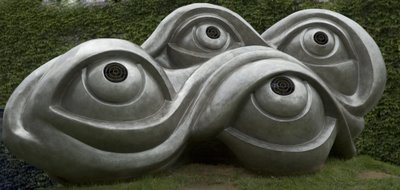Behold your God.

We were in New York to meet our old pal Ed at the Guggenheim, and, later, to hear Finnish Composer Kaija Saariaho's oratorio, The Passion of Simoneproduced in collaboration with Peter Sellars and performed at the Mostly Mozart Festival at Lincoln Center. As you may recall, DK wrote a jazz oratorio The Death of Simone Weil using a long poem of mine. So we were most interested to hear another extended work inspired by the same figure.
But first came Ed, the Guggenheim, and an exhibit of the works of artist/sculptor Louise Bourgeois. None of us knew her work, even though, as it turns out, I'd photographed a sculpture of hers two years ago. She's 97, and still working.

As I made my way up the museum's spiral ramp into the generous retrospective of her work I grew more and more disconcerted. The first images were early drawings: chimeric, witty fusions of women and buildings. Then came the sculptures. Clusters of spindly, humanoids gave way to other more dramatic and aggressive biomorphic forms -- hermaphroditic, headless chimeras, womblike/phallic objects, globular, sprouting, growing, mammary, organic, glandular, excremental, biologic, twisted -- some tender, many agonized. There were altars, sickbeds, stretchers, banquet and operating tables. There was angst, mutilation, cannibalism, abuse, all rendered in marble, stone and metal.

The cumulative effect of these forms was viscerally disturbing. I found myself standing in great relief before several less bodily pieces -- a stack of interlocking wood blocks painted black and red; beside it, a tall dresser-like structure painted a tender, baby blue; then, a blue cabinet full of clear glassware: glasses, carafes, mason jars, bell jars, cheese domes, illuminated from within in a delicate and beautiful manner; finally, a monlithic, irregular black wood block inset on top with multiple, inverted glass domes. A medical procedure. Cupping, DK whispered. He was right. I'd been contemplating the abstract juxtaposition of the heavy, black base with the delicate, transparent glass; it became a massive afflicted body undergoing a painful medical treatment.

And after these came what I most admired: Ms. Bourgeois' Cells -- installation/collage-like spaces delimited by spiraling walls constructed out of old doors, into which one peers like a voyeur at intimate collections of significant objects: pairs of sculpted hands almost impossibly (I tried) interlaced, sickbeds, medical devices, spiders, threaded needles, nightgowns, stairways to nowhere, massive spheres, a toy caboose on a bed, a large candelabra-like display of industrial-sized spools of red thread, staircases, spheres -- expressing deep female angsts and oppressions and secrets, the natural outgrowth of of her early drawings of chimeric woman/buildings. And it was a visual vocabulary I instinctively understood -- in the way that music is understood.

Bourgeois' art disturbed and unsettled me, catapulted me beyond the ordinary, and set up painful resonances . I went out into the late afternoon exhausted by it, grateful for it, and also grateful for the distraction of gathering stormclouds, fitful rain and thunder rolling between the highrises of the city -- a storm, we would learn later, that had Manhatten briefly under a tornado warning. We waved good-bye to Ed and set out toward dinner -- a vegan dinner, thanks to my thoughtful, provident husband.
Bourgeois' visual meditations on affliction and incarnation seemed an appropriate prelude to what we were about to hear: an oratorio on the life of that tormented paragon of cerebral disembodiment, Simone Weil.
No comments:
Post a Comment